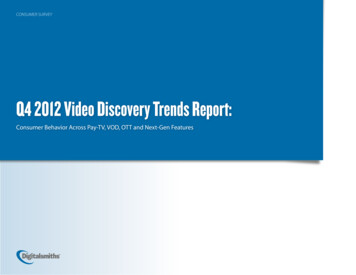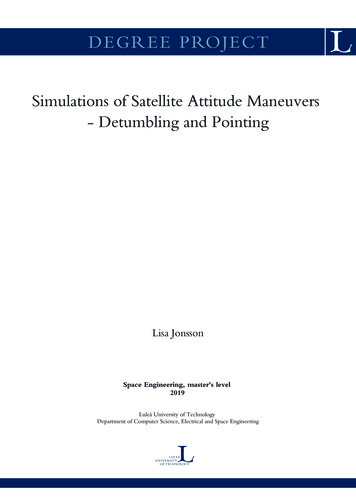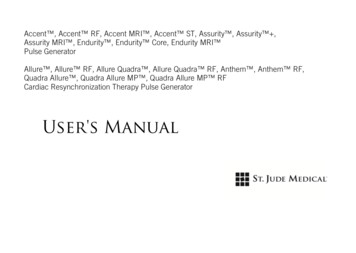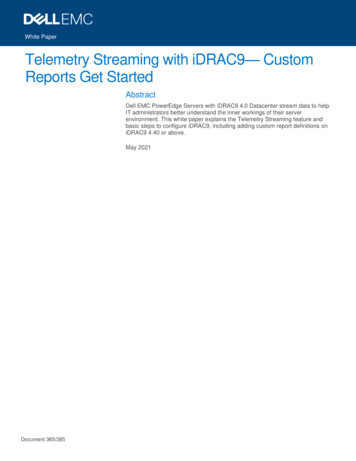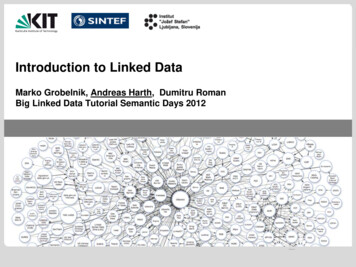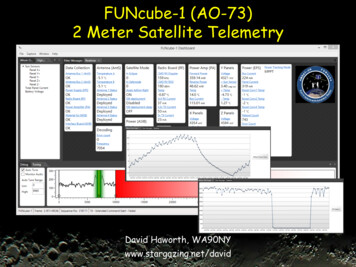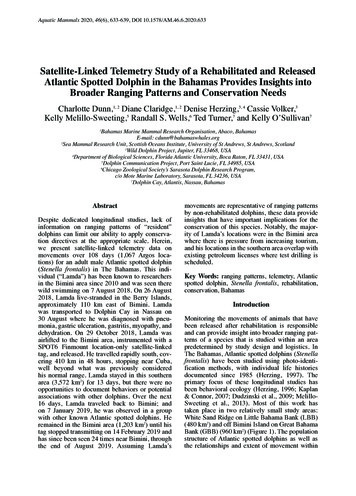
Transcription
Aquatic Mammals 2020, 46(6), 633-639, DOI 10.1578/AM.46.6.2020.633Satellite-Linked Telemetry Study of a Rehabilitated and ReleasedAtlantic Spotted Dolphin in the Bahamas Provides Insights intoBroader Ranging Patterns and Conservation NeedsCharlotte Dunn,1, 2 Diane Claridge,1, 2 Denise Herzing,3, 4 Cassie Volker,3Kelly Melillo-Sweeting,5 Randall S. Wells,6 Ted Turner,7 and Kelly O’Sullivan7Bahamas Marine Mammal Research Organisation, Abaco, BahamasE-mail: cdunn@bahamaswhales.orgSea Mammal Research Unit, Scottish Oceans Institute, University of St Andrews, St Andrews, Scotland3Wild Dolphin Project, Jupiter, FL 33468, USA4Department of Biological Sciences, Florida Atlantic University, Boca Raton, FL 33431, USA5Dolphin Communication Project, Port Saint Lucie, FL 34985, USA6Chicago Zoological Society’s Sarasota Dolphin Research Program,c/o Mote Marine Laboratory, Sarasota, FL 34236, USA7Dolphin Cay, Atlantis, Nassau, Bahamas12AbstractDespite dedicated longitudinal studies, lack ofinformation on ranging patterns of “resident”dolphins can limit our ability to apply conservation directives at the appropriate scale. Herein,we present satellite-linked telemetry data onmovements over 108 days (1,067 Argos locations) for an adult male Atlantic spotted dolphin(Stenella frontalis) in The Bahamas. This individual (“Lamda”) has been known to researchersin the Bimini area since 2010 and was seen therewild swimming on 7 August 2018. On 26 August2018, Lamda live-stranded in the Berry Islands,approximately 110 km east of Bimini. Lamdawas transported to Dolphin Cay in Nassau on30 August where he was diagnosed with pneumonia, gastric ulceration, gastritis, myopathy, anddehydration. On 29 October 2018, Lamda wasairlifted to the Bimini area, instrumented with aSPOT6 Finmount location-only satellite-linkedtag, and released. He travelled rapidly south, covering 410 km in 48 hours, stopping near Cuba,well beyond what was previously consideredhis normal range. Lamda stayed in this southernarea (3,572 km2) for 13 days, but there were noopportunities to document behaviors or potentialassociations with other dolphins. Over the next16 days, Lamda traveled back to Bimini; andon 7 January 2019, he was observed in a groupwith other known Atlantic spotted dolphins. Heremained in the Bimini area (1,203 km2) until histag stopped transmitting on 14 February 2019 andhas since been seen 24 times near Bimini, throughthe end of August 2019. Assuming Lamda’smovements are representative of ranging patternsby non-rehabilitated dolphins, these data provideinsights that have important implications for theconservation of this species. Notably, the majority of Lamda’s locations were in the Bimini areawhere there is pressure from increasing tourism,and his locations in the southern area overlap withexisting petroleum licenses where test drilling isscheduled.Key Words: ranging patterns, telemetry, Atlanticspotted dolphin, Stenella frontalis, rehabilitation,conservation, BahamasIntroductionMonitoring the movements of animals that havebeen released after rehabilitation is responsibleand can provide insight into broader ranging patterns of a species that is studied within an areapredetermined by study design and logistics. InThe Bahamas, Atlantic spotted dolphins (Stenellafrontalis) have been studied using photo-identification methods, with individual life historiesdocumented since 1985 (Herzing, 1997). Theprimary focus of these longitudinal studies hasbeen behavioral ecology (Herzing, 1996; Kaplan& Connor, 2007; Dudzinski et al., 2009; MelilloSweeting et al., 2013). Most of this work hastaken place in two relatively small study areas:White Sand Ridge on Little Bahama Bank (LBB)(480 km2) and off Bimini Island on Great BahamaBank (GBB) (960 km2) (Figure 1). The populationstructure of Atlantic spotted dolphins as well asthe relationships and extent of movement within
634Dunn et al.these two areas are well-studied (Danaher-Garciaet al., 2019). However, habitat use and rangingpatterns by Atlantic spotted dolphins elsewherein The Bahamas is unknown as sighting reportsfrom these areas are largely from the public on anopportunistic basis, although Herzing et al. (2017)documented the one-time movement of spotteddolphins between these two areas, suggestinglonger range movements do occur.The existing studies by the Wild Dolphin Project(WDP) and the Dolphin Communication Project(DCP) have predominantly used either small vessels that conduct daily surveys and return to landat the end of each day or medium-sized vessels thattravel to areas where dolphin sighting rates havebeen historically high and remain nearby for multiple days observing the animals. Given the vastextent of the western side of the Bahama banks(700 km long), the potential dolphin habitat is large.On LBB, Atlantic spotted dolphins move offshore to forage at night and inshore to socializeand rest during the day (Herzing & Elliser, 2013).Offshore nocturnal feeding has also been observedoff Bimini (WDP, unpub. data), with shallowbank waters used for daytime socializing andrest (Melillo et al., 2009; Dudzinski et al., 2012).Given its proximity to Florida, Bimini’s marineFigure 1. Map of The Bahamas showing Little BahamaBank and Bimini on Great Bahama Bank where studies ofAtlantic spotted dolphins (Stenella frontalis) have takenplaceenvironment has growing pressure from tourism with cruise ships and many activities, including increasing wild dolphin watching, swim-withprograms, and high-speed boating. Ongoing andpotentially increasing vessel noise disturbancecould have an impact on the health of these animals, as well as an increased risk of the more directconsequences of vessel strikes in waters shared byresting dolphins and high-speed vessels.This article presents the first case of a stranding, rehabilitation, release, and satellite trackingof an individual Atlantic spotted dolphin previously known by researchers. Through this collaborative effort, new questions about the extendedrange of small, coastal dolphins are posed.MethodsThe Bahamas Marine Mammal Stranding Network,run by The Bahamas Marine Mammal ResearchOrganisation (BMMRO), received a report ofa dolphin in distress at Great Stirrup Cay in theBerry Islands, The Bahamas, on 26 August 2018.The animal had been sighted initially that morninghanging vertically in shallow water close to shore,with its tail touching the sandy bottom. BMMROinformed the Atlantis Dolphin Cay facility to initiate a rescue operation. The Atlantis team arrived onsite the following day and intubated the animal with1 liter of fluids for dehydration and administeredan antibiotic injection (Meropenem). The dolphinwas not sighted on 28 August but was found drystranded on a beach on 29 August and was transported to the Atlantis facility in Nassau via seaplanethe next day.The dolphin was transported directly from thestranding site to a harbourside, open-ocean facility at Atlantis Dolphin Cay in Nassau where heremained for the entirety of his rehabilitation.Shortly after arriving at Dolphin Cay, identification photographs of the dolphin were sharedwith WDP and DCP to determine if they had anyrecords of this individual. Similar to Würsig &Würsig (1977) and Herzing (1996), they useda series of marks from archived photographsto match the rescued dolphin to the cataloguedanimal known as “Lamda” (Figure 2).Lamda was initially placed in a small medicalpen adjacent to a larger sea pen during his earlyrecovery for 24 h. This was due to his initial lackof mobility, his need for flotation support, andto facilitate emergency treatment. He was thenmoved to the larger sea pen and treated for pneumonia, gastric ulceration, gastritis, myopathy,and dehydration. Treatments included calcium;vitamin E; antibiotics for 5 wks, including a-carbapenem, penicillin and a-quinolone; antifungals;dextrose and fluids; vitamins; an opioid agonist
Telemetry of Released Stenella frontalis635Figure 2. Atlantic spotted dolphin, Lamda, showing thenatural pattern of spots used to match the cataloguedindividual observed off Bimini (A) to the rescued animal (B)analgesic; a H-2 antagonist; low dose glucocorticoids; and swimming physiotherapy. There wereno treatments during the last 4 wks of the 9-wkrehabilitation period.Handling protocols during rehabilitation werestrictly maintained to avoid incidental/adventitiousconditioning of behavior not supportive of wildrelease and survival. Lamda was offered tossedonly (no hand feeding) capelin or herring every 2 hfrom 0630 until 0030 h EST and had a maximumdaily intake of 8.5 kg. During his rehabilitation,Lamda put on 0.45 kg per day, and his treatmentremoved all signs of pneumonia, gastritis, gastriculcers, and gastro-intestinal stasis. As Lamda’shealth stabilised, his activities expanded, including increased vocalisations, sea pen exploration,fish chasing, and periodic preying on needlefish.Combined with rapid health recovery, a relativelyshort duration in managed care, knowledge of theanimal’s home range, and logistical capabilities tofacilitate a low-risk transport to his former range,a wild-release plan was initiated. Final diagnosticsfor a last health assessment, including repeat thoracic radiographs and blood sampling, concludednormal health; and permission from the BahamasDepartment of Marine Resources was granted totransport, tag, and release Lamda.Given Lamda’s long-term use of the area,Bimini was chosen as the release site; and on29 October 2018, Lamda was transported from theAtlantis Dolphin Cay facility via a flatbed truck toNassau International Airport and into a Caravanseaplane. Lamda and six personnel flew to theBimini area where the seaplane landed on thewater in Bimini harbour. Lamda was transferredto a small vessel which transported him to an areaknown to be frequented by Atlantic spotted dolphins where he was released into the ocean.While aboard the small vessel, 15 min prior tohis release, Lamda was fitted with a SPOT6 location-only tag (PTT 128251; Wildlife Computers,Inc., Redmond, WA, USA) provided by theChicago Zoological Society’s Sarasota DolphinResearch Program (Figure 3). The tag was attachedFigure 3. Lamda just after being fitted with SPOT6 tag(Wildlife Computers, Inc.) aboard the release vessel on29 October 2018as per protocols used by Wells et al. (1999) andprogrammed to transmit 315 locations per daymade up of 35 transmissions per hour for eachtransmission hour block. Transmission blockswere selected to (1) optimize satellite availability,(2) make remote tracking available for searchingfor the tagged animal in real time, and (3) optimize transmission times to keep battery consumption to a minimum. The tag was set to transmitbetween 0500-1159 h and 2100-2259 h EST until4 November when it changed to 0400-1059 h and2000-2159 h EST due to daylight savings time.These allocations were based on the ARGOSonline satellite pass prediction values, looking forsatellites with 20 elevation for at least 3 min.This took advantage of all satellites and providedlocation data first thing in the morning before heading into the field and while in the field. The potential battery life was estimated as 180 to 240 d.Satellite-linked telemetry location estimatesand spatial error information from this tag wereretrieved via the Argos system (www.Argossystem.org). The predicted locations were estimated at regular intervals from irregularly spacedArgos telemetry fixes by fitting a ContinuousTime Correlated Random Walk (CTCRW) model(Johnson et al., 2008) using the R package ‘crawl’(Version 2.1; Johnson, 2017) to filter out spatialoutliers. This CTCRW model uses error ellipseestimates that rely on the Argos Kalman-filteralgorithm (Lowther et al., 2015). To search fornocturnal feeding forays as previously describedby Herzing & Elliser (2013), locations weresplit into day and night using sunrise and sunset(https://www.timeanddate.com; Bimini Islands,Bahamas) as delimiters.
636Dunn et al.In December 2019, January 2020, and February2020, an 11-m outboard vessel was used by DCPto search for Lamda using locations received fromthe tag. Once the tag had detached, searches forLamda around the Bimini area were made throughAugust 2019 using boat-based surveys by WDPand DCP, utilizing established data collection protocols (e.g., Herzing, 1997; Danaher-Garcia et al.,2019).ResultsLamda was known previously to WDP and DCP.DCP first observed this male in 2010 when he wasestimated to be 2 to 3 y old based on limited spotdevelopment and close interaction with his presumed mother. Prior to stranding, Lamda had beendocumented 37 times between 2010 and 2018(2010, 2 d; 2011, 2 d; 2012, 1 d; 2013, 2 d; 2014,6 d; 2015, 3 d; 2016, 5 d; 2017, 7 d; and 2018, 9 d)and was last seen by WDP near Bimini on7 August 2018. When Lamda was present, groupsizes ranged from 6 to 45 individuals. At the timeof his stranding, Lamda was estimated to be atleast 10 y old.Satellite-linked telemetry data showed that,immediately following release, Lamda swamsouth continuously for 48 h, covering 410 km,to an area well beyond what was considered hisnormal range. He did remain within habitat appropriate for this species, however. He spent 13 d inthis southern area and then 16 d traveling back tohis release site, staying close to the western edgeof the GBB (Figure 4).High-quality observed locations around theBimini area provided 335 daytime positions and424 nighttime positions. Plotting the day andnight locations of Lamda around the Bimini areasuggests a slight movement offshore and a greaterarea used at night (Figure 5); however, there areno significant differences between day and night(Wilcoxon-Signed Rank test, p value 0.17).Once back in the Bimini area, several attemptsto observe Lamda were made by DCP before successfully sighting him on 7 January 2019 in a groupof approximately 26 dolphins (Figure 6; a videoof this sighting is available in the SupplementalMaterial section of the Aquatic Mammals x.php?option com content&view article&id 10&Itemid 147). This was a mixed species (S. frontalis with common bottlenose dolphins [Tursiopstruncatus]), mixed age, mixed sex group. Surfaceand underwater recordings indicated that Lamdaappeared physically well, and the tag attachment remained secure. This sighting was withinLamda’s pre-stranding range and included his previous known associates.Lamda’s tag last transmitted on 14 February2019. Photographs of Lamda on 2 May 2019,also taken near Bimini, show the tag no longerattached and the wound healing (Figure 7).At the time of publication, Lamda had beenseen 24 times post-release in group sizes rangingbetween 3 to 46 (mode: 20 animals). He was lastsighted on 28 August 2019.DiscussionBased on exceeding the 42-d post-release tracking threshold identified by Wells et al. (2013),the rehabilitation and release of Lamda has beendeemed a success. Previous data on release following rehabilitation of dolphins with pneumoniashow that only one in four bottlenose dolphins’releases were successful (Wells et al., 1999).Although Davis et al. (1996) documented tag datafor a released Atlantic spotted dolphin, our studypresents the first documentation of rehabilitation,release, and post-release monitoring, includingafter tag detachment, of a stranded Atlantic spotted dolphin back to the wild.Lamda’s short time under human care andshort transport to his release site likely contributed to Lamda’s successful re-adaptation to thewild (Wells et al., 2013). In many rehab–releasecases, it is not possible to directly observe thereleased cetaceans because they are not accessibleto observers. Lamda provided a unique opportunity for follow-up monitoring: his nearshore habitat use enabled repeated observations for severalmonths post-release, along with the ability tomonitor his body condition and his re-assimilationsocially with other dolphins.Lamda was observed within similar grouptypes pre- and post-stranding—that is, he wasobserved in both single species and mixed species (S. frontalis and T. truncatus) groups as wellas mixed age and mixed sex groups. The groupsizes in which Lamda was seen post-release hadsimilar variance to those he had been seen inacross the years pre-stranding; however, he wassighted more frequently post-release. A possibleexplanation for the increase in Lamda sightingsin 2019 may be that the scar from the tag madehim more readily identifiable, even from a distance. The lack of sightings since August 2019 isdue to decreased field work in The Bahamas following Hurricane Dorian on 1 September 2019,and more recently because of COVID-19.Atlantic spotted dolphins have been documented moving off the bank edge at night to feedboth off Bimini (Herzing, pers. comm., 2019)and White Sand Ridge, LBB (Herzing & Elliser,2013). Although our satellite-derived locationsalso suggest this pattern, there may not have been
Telemetry of Released Stenella frontalis637Figure 4. Satellite-linked track of Lamda’s movements from his 29 October 2018 release until his tag stopped transmittingon 14 February 2019, showing the scale for 1º of longitude; blue square Lamda’s stranding location in the Berry Islands,blue triangle rehabilitation location in Nassau, black circle release location near Bimini, yellow triangle his location atlast transmission, and red diamond the Bahamas Petroleum Company’s Exploratory Drilling Well. Water depth contoursindicated in meters.enough spatial resolution to show fine-scale movement with Argos telemetry given the steepness ofthe edge of the bank. GPS technology might haveprovided better resolution for fine-scale analyses;however, suitable tags were not available at thetime of Lamda’s release.Public sighting records collected by BMMROover the last three decades have documentedAtlantic spotted dolphins distributed throughoutThe Bahamas, including the area where Lamdastranded; in the Berry Islands (BMMRO, unpub.data); and along the southwestern edge of theGBB (Melillo et al., 2009), where he was trackedimmediately following release.There is important significance for conservation from our findings. Although Lamda and
638Dunn et al.Figure 5. Enlarged map of the Bimini area (gray shape) showing the bathymetry (m) and Lamda’s satellite-linked locationsduring the day (A) and night (B) from 28 November 2018 to 14 February 2019Figure 6. Lamda near Bimini with his tag still securelyattached, 7 January 2019Figure 7. First sighting of Lamda without his tag on 2 May2019his known associates are considered resident tothe Bimini area, it is not uncommon for severalweeks or more to pass between observations ofany one individual. The high speed and consistentdirectionality of Lamda’s travel post-release suggest that he was not travelling in a random direction but that his previous movements may haveincluded these more distant areas. The southernarea overlaps with existing petroleum licenseswhere test drilling is scheduled despite the lackof information on cetacean use of the proposeddrill site. However, his return to Bimini and thenhigh use of the area suggest that the Bimini areamay in fact be a preferred habitat for this groupof Atlantic spotted dolphins. The marine environment immediately surrounding Bimini isexperiencing increasing pressure from tourism,which includes increased boat traffic. Severalof the spotted dolphins that moved from LBB tothe Bimini area of the GBB were observed withsevere boat propeller marks during the first 2 yafter their move (Herzing et al., 2017).Resident dolphin populations provide valuableopportunities to conduct longitudinal research projects, often serving as the baseline from which futurechanges can be gleaned. However, Lamda’s individual tracking data points to the gap in knowledgeof the true extent of this species’ range. This further insight into the behavioral ecology of Atlanticspotted dolphins raises additional conservationconcerns, supporting the need for continued andexpanded study.
Telemetry of Released Stenella frontalisAcknowledgmentsThe authors would like to thank Alan Davies andMatt Blomer for reporting the distressed dolphin to The Bahamas Marine Mammal StrandingNetwork. We would also like to thank the AtlantisBlue Project Foundation for funding The BahamasMarine Mammal Stranding Network. MartaCremer, Universidade da Região de Joinville,UNIVILLE, is acknowledged for her role in providing the tag to the Chicago Zoological Society’sSarasota Dolphin Research Program, and theChicago Zoological Society supported trackingefforts and Argos satellite-linked data processing.Thanks to Trevor Joyce who provided some analysis guidance; and finally, thanks to the BahamasDepartment of Marine Resources for their help inexpediting research permit approval for the tagand release of Lamda.Literature CitedDanaher-Garcia, N. A., Melillo-Sweeting, K., & Dudzinski,K. M. (2019). Social structure of Atlantic spotted dolphins (Stenella frontalis) off Bimini, The Bahamas(2003-2016): Alternate reasons for preferential association in delphinids. acta ethologica, 23, 9-12. https://doi.org/10.1007/s10211-019-00329-3Davis, R. W., Worthy, G. A. J., Würsig, B., Lynn, S. K.,& Townsend, F. I. (1996). Diving behavior and at-seamovements of an Atlantic spotted dolphin in the Gulfof Mexico. Marine Mammal Science, 12(4), b00069.xDudzinski, K. M., Gregg, J. D., Ribic, C. A., & Kuczaj, S. A.(2009). A comparison of pectoral fin contact between twodifferent wild dolphin populations. Behavioural Processes,80, 182-190. ski, K. M., Gregg, J., Melillo-Sweeting, K., Seay, B.,Levengood, A., & Kuczaj II, S. A. (2012). Tactile contact exchanges between dolphins: Self-rubbing versusinter-individual contact in three species from threegeographies. International Journal of ComparativePsychology, 25, 21-43.Elliser, C. R., & Herzing, D. L. (2013). Long-term social structure of a resident community of Atlantic spotted dolphins,Stenella frontalis, in the Bahamas 1991-2002. MarineMammal Science, 30(1), 308-328. https://doi.org/10.1111/mms.12039Herzing, D. L. (1996). Vocalizations and associatedunderwater behavior of free-ranging Atlantic spotteddolphins, Stenella frontalis, and bottlenose dolphins,Tursiops truncatus. Aquatic Mammals, 22(2), 61-79.Herzing, D. L. (1997). The life history of free-ranging Atlanticspotted dolphins (Stenella frontalis): Age classes, colorphases and female reproduction. Marine Mammal Science,13(4), 576-595. 639Herzing, D. L., & Elliser, C. R. (2013). Nocturnal feedingof Atlantic spotted dolphins (Stenella frontalis) in TheBahamas. Marine Mammal Science, 30(1), 367-373.https://doi.org/10.1111/mms.12016Herzing, D. L., Augliere, B. N., Elliser, C. R., Green, M. L.,& Pack, A. A. (2017). Exodus! Large-scale displacement and social adjustments of resident Atlantic spotted dolphins (Stenella frontalis) in the Bahamas. PLOSONE, 12(8), e0180304. n, D. S. (2017). crawl: Fit continuous-time correlated random walk models to animal movement data.R package version 2.1.0. https://CRAN.R-project.org/package crawlJohnson, D. S., London, J. M., Lea, M. A., & Durban, J. W.(2008). Continuous-time correlated random walk modelfor animal telemetry data. Ecology, 89, 1208-1215. https://doi.org/10.1890/07-1032.1Kaplan, J. D., & Connor, R. C. (2007). A preliminary examination of sex differences in tactile interactions among juvenile Atlantic spotted dolphins (Stenella frontalis). MarineMammal Science, 23(4), 943-953. wther, A. D., Lydersen, C., Fedak, M. A., Lovell, P., &Kovacs, K. M. (2015). The Argos-CLS Kalman filter:Error structures and state-space modelling relative toFastloc GPS data. PLOS ONE, 10(4), e0124754. o, K. E., Dudzinski, K. M., & Cornick, L. A. (2009).Interactions between Atlantic spotted (Stenella frontalis)and bottlenose (Tursiops truncatus) dolphins off Bimini,The Bahamas, 2003-2007. Aquatic Mammals, 35(2),281-291. eeting, K., Turnbull, S. D., & Guttridge, T. L.(2013). Evidence of shark attacks on Atlantic spotteddolphins (Stenella frontalis) off Bimini, The Bahamas.Marine Mammal Science, 30(3), 1158-1164. https://doi.org/10.1111/mms.12082Wells, R. S., Fauquier, D. A., Gulland, F. M. D., Townsend,F. I., & DiGiovanni, R. A., Jr. (2013). Evaluating postintervention survival of free-ranging odontocete cetaceans.Marine Mammal Science, 29(4), E463-E483. https://doi.org/10.1111/mms.12007Wells, R. S., Rhinehart, H. L., Cunningham, P., Whaley, J.,Baran, M., Koberna, C., & Costa, D. P. (1999). Longdistance offshore movements of bottlenose dolphins.Marine Mammal Science, 15(4), 1098-1114. Würsig, B., & Würsig, M. (1977). The photographic determination of group size, composition, and stability of coastalporpoises (Tursiops truncatus). Science, 198(4318), 755756. https://doi.org/10.1126/science.198.4318.755
The existing studies by the Wild Dolphin Project (WDP) and the Dolphin Communication Project (DCP) have predominantly used either small ves-sels that conduct daily surveys and return to land at the end of each day or medium-sized vessels that travel to areas where dolphin sighting rates have been historically high and remain nearby for mul-

